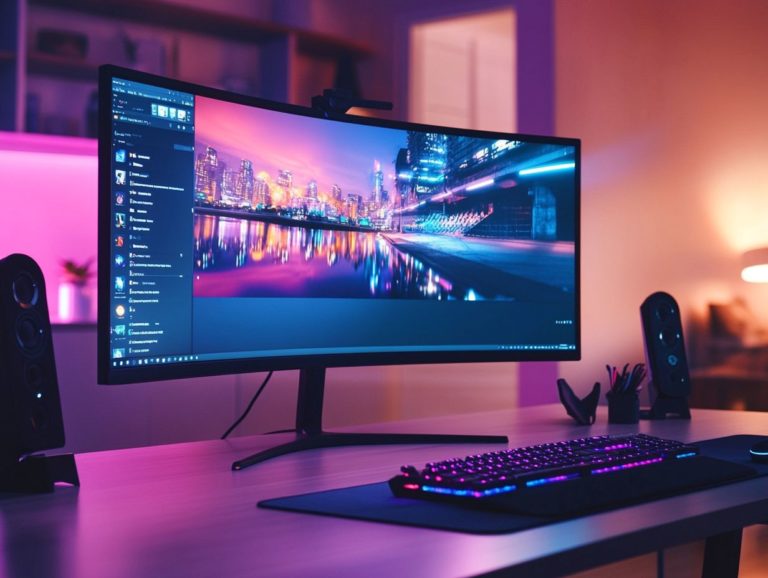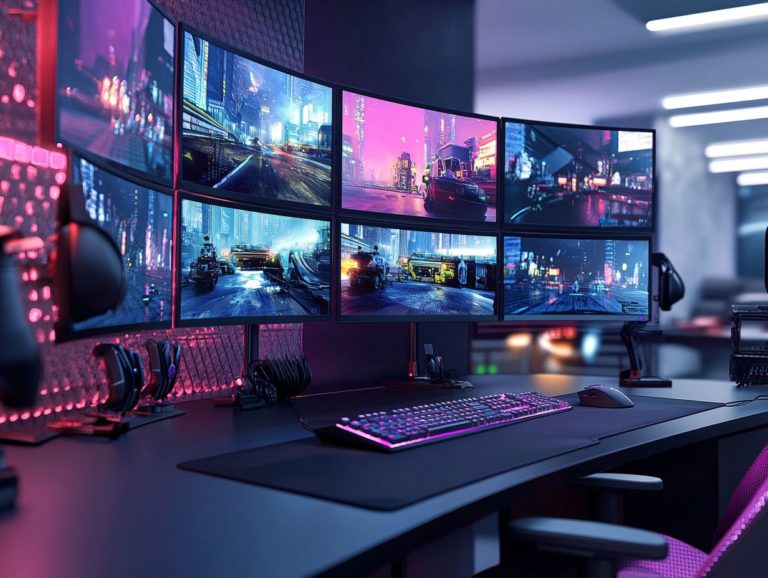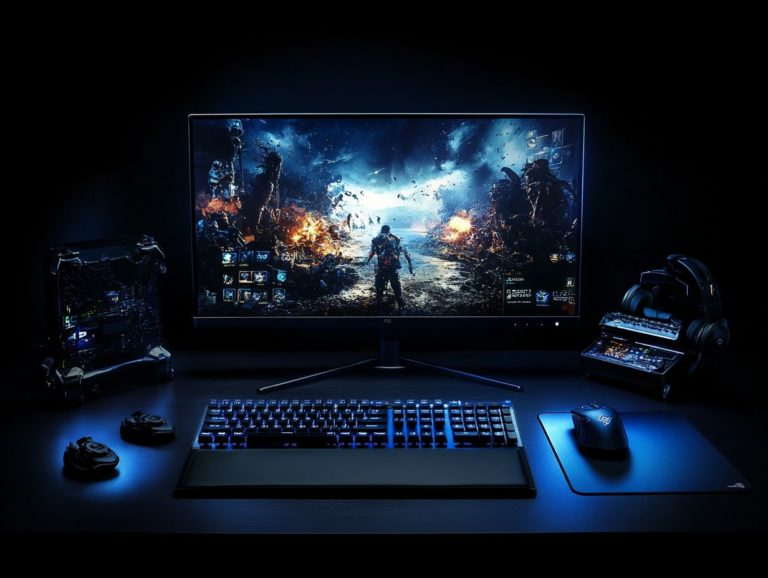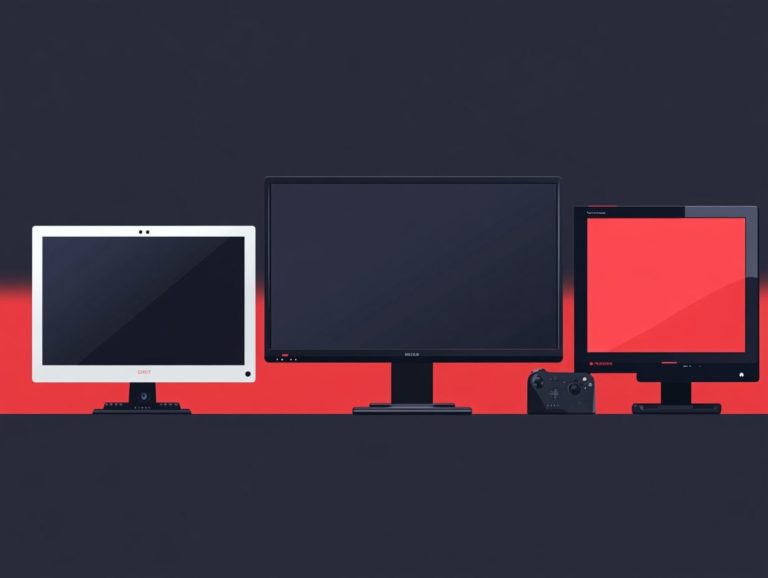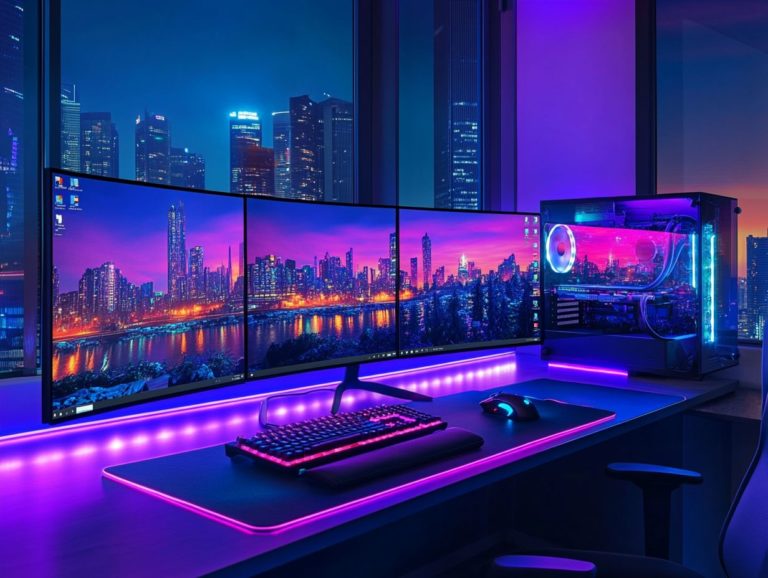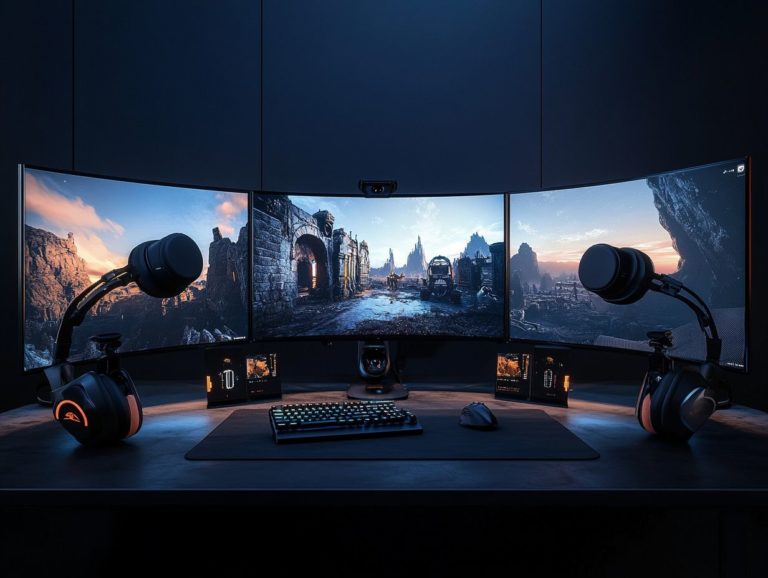how to use a monitor for game development
In the fast-paced realm of game development, the tools you select can truly change the game. A high-quality monitor is essential for transforming your creative vision into reality.
Let s dive into why monitors are a game changer for your development process! This article guides you from choosing the right monitor to optimizing your setup for peak productivity.
Explore how multiple displays can elevate your workflow, discover the best software tools to harness, and equip yourself with troubleshooting tips for common issues.
Whether you re just starting out or you re a seasoned developer, this guide will empower you to maximize your gaming projects and elevate your craft.
Contents
- Key Takeaways:
- Choosing the Right Monitor for Game Development
- Setting Up Your Monitor for Game Development
- Utilizing Multiple Monitors for Game Development
- Tools and Software for Game Development on a Monitor
- Maximizing Productivity with a Monitor
- Troubleshooting Common Monitor Issues for Game Development
Key Takeaways:

- Choosing the right monitor greatly impacts your work quality.
- Optimize display settings and consider multiple monitors.
- Use tips to streamline your workflow and troubleshoot issues.
Why a Monitor is Essential for Game Development
A high-quality monitor is absolutely essential for your game development endeavors. It directly impacts your productivity and efficiency in a multitude of critical tasks.
Whether you re coding in a dimly lit room or conducting rigorous game tests, the monitor you choose plays a significant role in color representation, refresh rates, and overall workflow.
Opting for a monitor with excellent color accuracy and high resolution is pivotal for crafting visually stunning environments and ensuring that physical materials look right in your projects.
Don’t underestimate the importance of how smoothly images move on screen; a higher refresh rate means smoother gameplay, allowing you to spot potential issues more effectively during testing.
For varied needs, specialized monitors like those that provide better color accuracy or ultra-wide displays for an expansive view are your best friends.
Models with adjustable settings can help reduce eye strain during long sessions, enhancing your overall health and productivity essential factors for meeting deadlines in the fast-paced gaming industry.
Choosing the Right Monitor for Game Development
Selecting the ideal monitor for game development requires thoughtful evaluation of several key factors, such as screen size, resolution, refresh rate, and color accuracy. For insights on the best monitors for game design work, this attention to detail ensures you have an efficient and enjoyable coding experience.
Whether you’re exploring mid-range alternatives or eyeing high-end options like the Dell U3223QE or Acer Nitro XV275K, it s essential to align your choice with your specific needs throughout the game development process.
For those who are budget-conscious, the LG 27UK650-W stands out as an excellent option, delivering impressive specifications without straining your finances.
With the right monitor, you re not just developing games; you re crafting experiences!
Factors to Consider when Selecting a Monitor
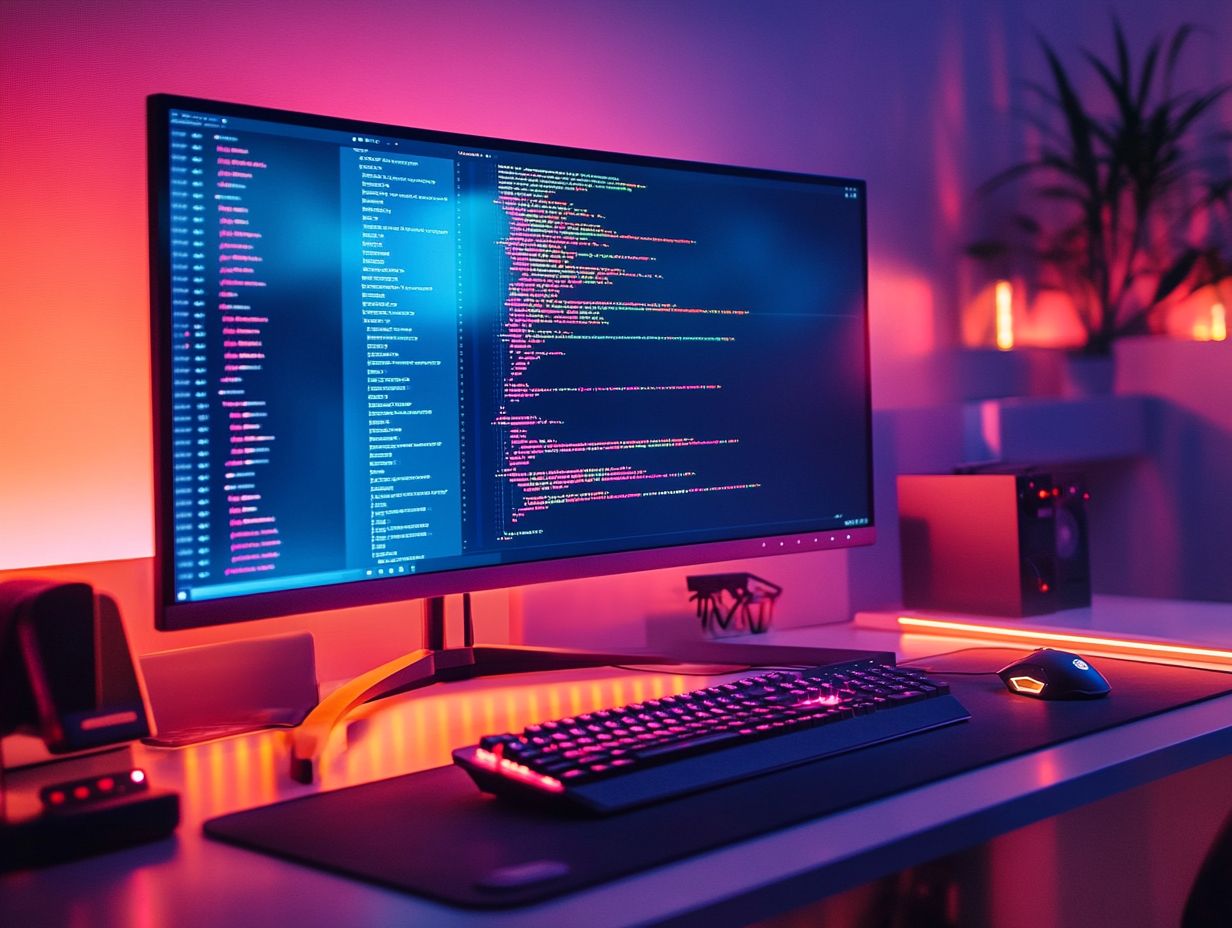
Selecting a monitor for game development involves key factors that can really improve your productivity and visual quality. Focus on refresh rate, pixel density, and color accuracy.
A monitor with a high refresh rate delivers smooth gaming experiences. Excellent color representation keeps your designs true to life.
Don t overlook resolution! Choosing a 4K monitor gives you superior detail, which is essential for intricate graphics.
Higher refresh rates enhance real-time game testing. This helps you identify and fix issues like motion blur and frame drops that can hurt player experience.
Increased pixel density sharpens visuals and helps artists create detailed textures. This is crucial for immersive environments.
Color accuracy ensures your final product matches your artistic vision, especially for characters and environments.
Using a monitor that excels in these areas streamlines your review and makes your workflow more efficient!
Setting Up Your Monitor for Game Development
Setting up your monitor properly can significantly boost your workflow and productivity.
Optimizing your monitor setup can transform your experience! Whether you use a dual-arm mount for desk space or DisplayPort Alt Mode for better connectivity, the right setup matters.
A KVM switch helps you easily switch between devices, creating a more efficient environment for coding and testing.
Optimizing Display Settings
Optimizing display settings is vital for the best visual experience while developing games. Accurate color representation and high refresh rates enhance gameplay.
Calibration ensures your monitor displays colors correctly, especially for HDR games. Adjust brightness, contrast, and color profiles to boost your workflow and game visuals.
Start by selecting the right color mode look for options like standard, gaming, or cinema. Then, adjust brightness to reduce glare while keeping dark scenes detailed.
Next, focus on contrast. A higher contrast ratio can create vivid images, but be careful not to wash out colors.
For calibration, use tools like DisplayCAL for precise settings. Software like f.lux also adjusts color temperature based on the time of day, refining your visual experience.
Taking these steps not only enhances your immediate visual feedback but also positively impacts your entire game development process!
Calibrating Color and Contrast
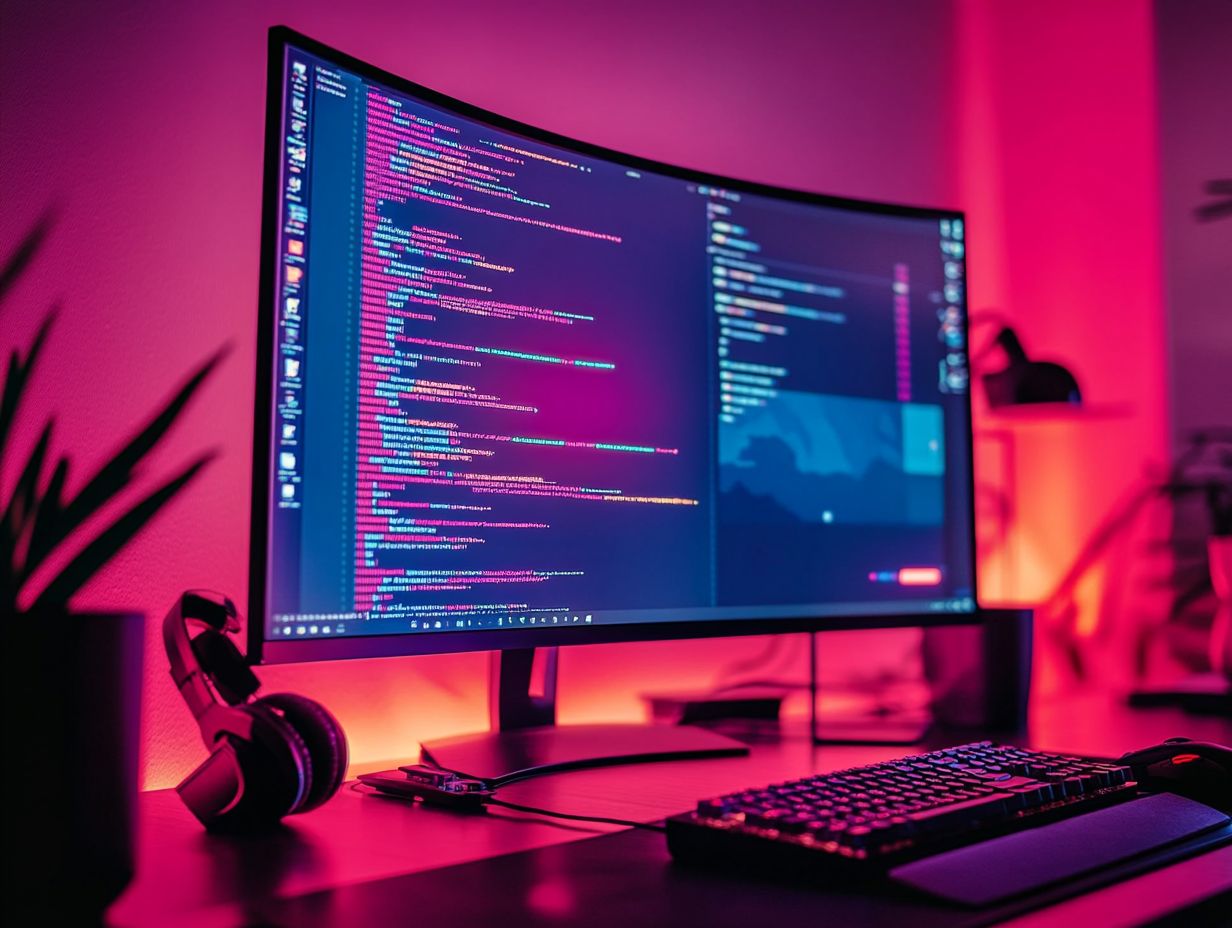
Calibrating color and contrast on your monitor is essential for precise color accuracy in game development.
This ensures what you see on-screen aligns with your creative vision.
Use calibration tools to fine-tune settings like gamma (which affects brightness), white balance (which ensures colors appear true), and color temperature (which adjusts the warmth or coolness of colors).
By prioritizing these settings, you enhance your workflow and elevate the overall quality of your projects.
Get started with tools like a spyder or colorimeter for precise measurements.
It’s also wise to conduct calibration in controlled lighting to minimize external distortions.
Maintaining color fidelity is very important; it impacts user experience and enhances storytelling.
Dedicating time to proper calibration boosts productivity and strengthens your connection with your audience.
Utilizing Multiple Monitors for Game Development
Utilizing multiple monitors for game development can dramatically enhance your productivity by maximizing your screen real estate.
This setup facilitates efficient multitasking.
With setups that include three monitors or ultrawide screens, you can seamlessly code, test, and design all at once.
Features like Picture-in-Picture elevate this experience further, allowing you to monitor various aspects of your projects concurrently.
Benefits and Tips for Using Multiple Monitors
The advantages of using multiple monitors for game development are substantial. You can improve organization and test game elements in real-time.
This setup gives you the power to run different applications concurrently, such as using Unity 3D for coding and Adobe for graphic design.
This significantly enhances your efficiency and focus on complex tasks.
By strategically positioning your monitors, you can streamline your workflow and keep all essential tools within easy reach.
To maximize your productivity, consider configuring your displays to align with your work style.
For example, dedicate one monitor to your coding environment while the second showcases design tools. This drastically reduces the need to constantly switch tabs.
A triple monitor setup, with each screen assigned to coding, testing, and asset management, can elevate your experience even further.
Leverage software like display management tools to efficiently manage your windows for quick access to specific applications.
Maintaining a clutter-free desk and employing stands or mounts can help position your monitors at eye level, ensuring comfort for those long hours of development.
Tools and Software for Game Development on a Monitor
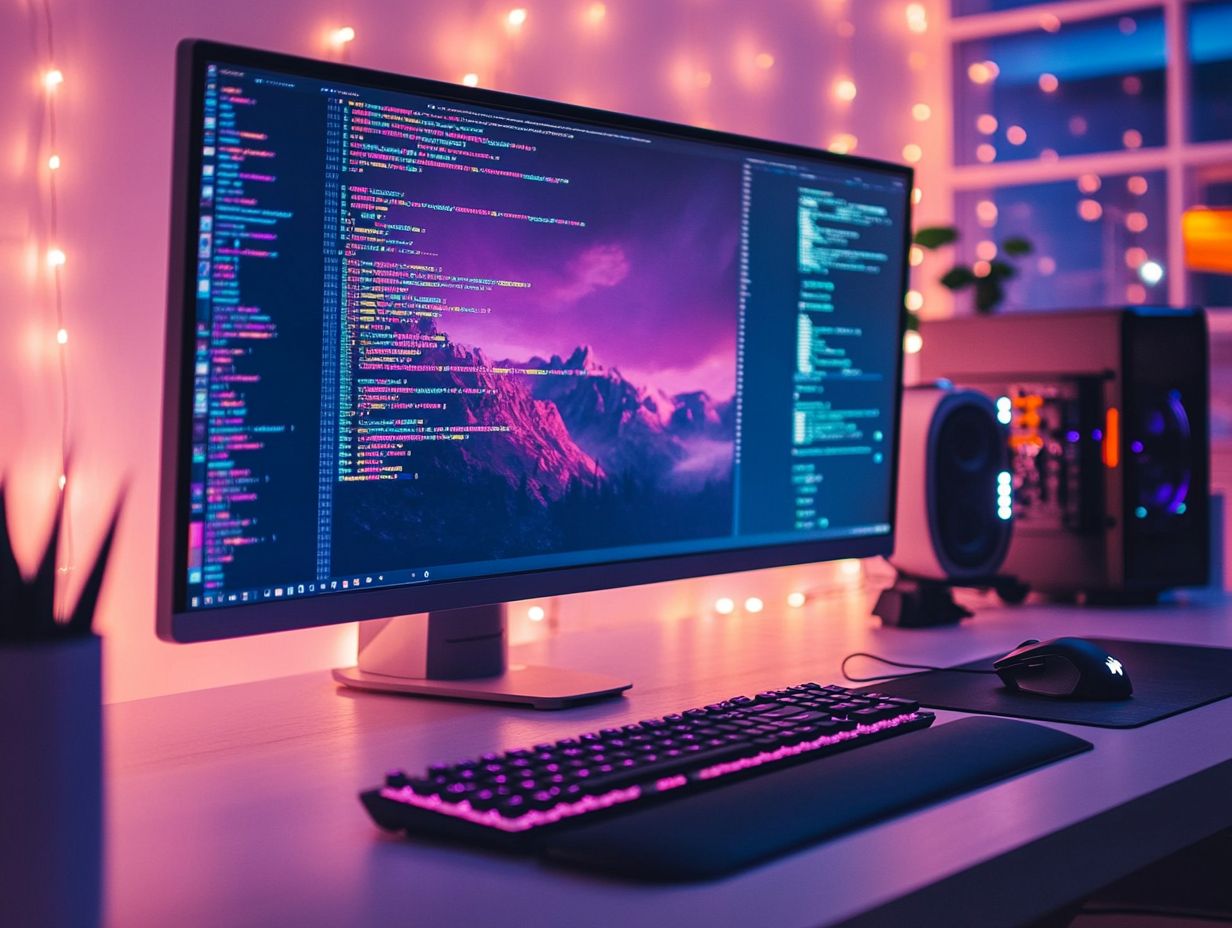
Utilizing the right tools and software on your monitor can elevate your game development process, ensuring a seamless workflow.
Programs like Unity 3D are essential for coding and game engine functionality.
Adobe software is pivotal for graphic design, giving you the power to craft high-quality visual assets.
The compatibility of these applications with your chosen monitor significantly influences performance and usability.
This underscores the importance of selecting the right hardware for your needs.
Recommended Programs and Resources
Popular tools for your game development journey include Unity 3D for game design and Adobe Creative Suite for graphic design.
These tools are essential for improving your work, offering a wide range of features from coding to asset creation.
The performance of these applications depends on your monitor setup. Ensure your hardware is compatible for the best development experience.
Take Unity 3D; it has a user-friendly interface and real-time rendering. These features empower you to bring your creative vision to life efficiently.
Adobe Creative Suite offers tools like Photoshop and Illustrator. These programs help you craft stunning visuals that captivate audiences.
When paired with high-resolution monitors, you boost productivity and gain clearer visual feedback.
This perfect match between robust software and superior monitor capabilities streamlines your design process. It allows you to spot and fix details with precision, elevating the quality of your games.
Maximizing Productivity with a Monitor
Boosting productivity with your monitor requires smart organization and strategic workflow techniques. These can enhance your coding efficiency and project management.
Using multiple monitors or an ultrawide screen helps optimize your workspace. This setup allows seamless transitions between coding, testing, and graphic design tasks.
Best practices in your setup can create a focused and highly productive development environment.
Organization and Workflow Tips
Effective organization and workflow strategies are essential for coding efficiency in game development. They help streamline tasks and manage multiple projects easily.
Create a monitor setup that suits your work style to significantly boost focus and productivity.
As a game developer, using project management tools like Trello or Asana can be a game-changer. These platforms track tasks and milestones, keeping your progress visible.
Pairing this with a dual-monitor setup makes everything more manageable. One screen can display your code, while the other serves as a real-time debug console or task tracker.
This spatial separation gives you a chance to reduce context switching, helping maintain your momentum.
Customizing your monitor layouts to highlight essential software can further enhance your workflow. Unlock your full potential as a developer!
Troubleshooting Common Monitor Issues for Game Development
Troubleshooting common monitor issues is crucial for game developers. It empowers you to tackle technical problems that may disrupt your workflow quickly.
Whether it’s refresh rate discrepancies or color calibration mismatches, proactive monitor maintenance can save you time during critical phases.
Mastering how to diagnose and resolve these issues ensures smoother coding and testing experiences. Your monitor will consistently meet the high demands of game development.
Dealing with Technical Problems
Technical issues with your monitor can be frustrating. A systematic troubleshooting approach empowers you to quickly identify and fix these problems.
Screen flickering, color distortion, and connectivity issues can disrupt your game development. Regular maintenance and knowledge of troubleshooting steps can lead to efficient solutions.
Start by checking all cable connections. Replace any damaged cables.
- If your screen flickers, adjusting the refresh rate in display settings often resolves the issue.
- For color distortion, calibrate your monitor using built-in software or external devices to restore accurate visuals.
- Regularly check for dust and debris to prevent overheating and extend your monitor’s lifespan.
Implement proactive measures like updating drivers and configuring settings for your projects. Doing this minimizes disruptions and keeps your workflow smooth.
Frequently Asked Questions
How do I connect my monitor to my computer for game development?
To connect your monitor, use a video cable like HDMI, DisplayPort, or DVI. Ensure your devices have compatible ports and plug in the cable. For laptops, you may need an adapter.
How do I adjust the display settings on my monitor for game development?
Access your computer’s display settings or the monitor’s settings. You can adjust resolution, refresh rate, and color settings to fit your game development needs. For optimal results, consider the best monitors for indie games and calibrate your monitor for accurate colors.
Do I need a specific type of monitor for game development?
While any monitor can work, a high refresh rate (at least 120Hz) and low response time are recommended for smoother gameplay. A monitor with high resolution and accurate color is also beneficial.
Can I use multiple monitors for game development?
Yes, using multiple monitors is great for multitasking and having more space for your development software. Check if your graphics card supports multiple monitors.
How can I make the most of my monitor for game development?
Adjust display settings, calibrate colors, and ensure your graphics card is updated. A high refresh rate and multiple monitors can significantly enhance your experience.
What should I consider when purchasing a monitor for game development?
Consider resolution, refresh rate, response time, and color accuracy. Ensure your graphics card supports the monitor’s specs. Think about using multiple monitors and features like built-in speakers or adjustable stands.

